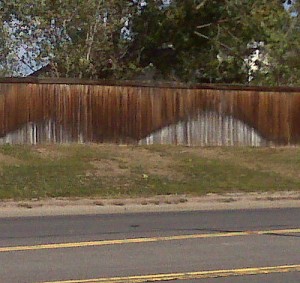This is my first in a series of “what not to do” posts related to landscape and site design.
One of the ways that I challenge myself to learn and to stay on top of the latest trends is to keep my eyes open for good and bad designs and ideas as I travel around my area or out of town.
The fence on the right is located near my home, in what appears to be an HOA (home owner’s association) maintained area next to a single family housing development. This is just one example of fences like this that can be found all over Denver. The root of the problem is that they have put sod directly against a wooden fence. Sod is typically irrigated by overhead spray and the water from the irrigation is discoloring and deteriorating the fence.
Problems with placing irrigation heads directly next to fencing
- Discolored fencing is unattractive: Obviously this is an aesthetics issue- these fences are a real eye-sore for these developments and the surrounding community.
- Shorter lifespan of the fence: Water is one of the most damaging elements for a fence. Irrigation systems often run every day, which discolors the fence and causes the wood to rot much sooner than it would naturally. The ground around the posts also gets saturated, which causes the posts to rot and even break off at the ground during high winds.
- Boring design: This type of street frontage design lacks creativity, and does not distinguish a place as unique for pedestrians or vehicles traveling by. Shrubs and ornamental grasses could be used instead to provide more visual interest- and choosing locally adapted or native plants give the area a stronger sense of place. These plantings also can help screen an older fence that is deteriorating.
- Additional landscape maintenance: Another less obvious issue with putting sod directly against a fence is that it requires additional maintenance to go back and trim the lawn at the bottom of the fence, where mowers can not get close enough to the fence.
Solutions
- Avoid planning and designing landscapes in this way. Instead of putting sod directly against the fence, design a planting bed that is a minimum of 5′ wide (or wider, depending on the design) against the base of the fence. Separate sod areas from the bed with an edger, and locate the irrigation spray heads at this new edge.
- If planting is not an option, then create a simple 2′ wide rock mulch strip on each side of the fence. Again, seperate this area from sod by using an edger and place irrigation outside of this strip.
- If you have an existing property with this problem, hire a landscape architect that specializes in site renovations (we would be an excellent choice) to design a renovation solution that meets your needs.
- Use drip irrigation for any planting beds against a fence. If there is no way to avoid having sod against your fence, consider using a sub-surface drip irrigation system that is designed for sod areas.
This is the official blog of Outdoor Design Group, Colorado Landscape Architects. For more information about our business and our services, click here.

A simple solution would be to place Sprinkler Shields between the fence and the sprinkler head to deflect the water from the fence. Not only would this prevent water stained fences, but they will also help to conserve water.
I have seen your product and agree it is a good quick fix solution to prevent fence damage. However, I do not see how this would save any water, the irrigation head will still be putting out the same amount of water.